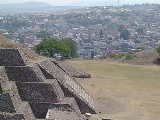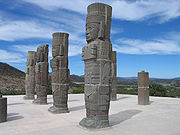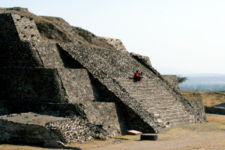
Tula, Hidalgo
Encyclopedia


Municipalities of Hidalgo
The Mexican state of Hidalgois made up of 84 municipalities :...
, in central-eastern Mexico
Mexico
The United Mexican States , commonly known as Mexico , is a federal constitutional republic in North America. It is bordered on the north by the United States; on the south and west by the Pacific Ocean; on the southeast by Guatemala, Belize, and the Caribbean Sea; and on the east by the Gulf of...
. The municipality covers an area of 305.8 km² (118.07 sq mi), and as of 2005, the municipality had a total population of 93,296, with 28,432 in the town. The municipality includes numerous smaller outlying towns, the largest of which are El Llano, San Marcos, and San Miguel Vindho.
It is located some 100 km to the north-northwest of Mexico City
Mexico City
Mexico City is the Federal District , capital of Mexico and seat of the federal powers of the Mexican Union. It is a federal entity within Mexico which is not part of any one of the 31 Mexican states but belongs to the federation as a whole...
. It covers part of the southeastern portion of the Pre-Columbian
Pre-Columbian
The pre-Columbian era incorporates all period subdivisions in the history and prehistory of the Americas before the appearance of significant European influences on the American continents, spanning the time of the original settlement in the Upper Paleolithic period to European colonization during...
city.
Nearby are the remains of the ancient capital city of the Toltec
Toltec
The Toltec culture is an archaeological Mesoamerican culture that dominated a state centered in Tula, Hidalgo in the early post-classic period of Mesoamerican chronology...
s, also known as "Tula" or as "Tollan
Tollan
Tollan, Tolan, or Tolán is a name used for the capital cities of two empires of Pre-Columbian Mesoamerica; first for Teotihuacan, and later for the Toltec capital, Tula-Hidalgo, both in Mexico...
". Usually identified as the Toltec capital around 980 CE, the city was destroyed at some time between 1168 and 1179. Tula became the capital city following Teotihuacan
Teotihuacan
Teotihuacan – also written Teotihuacán, with a Spanish orthographic accent on the last syllable – is an enormous archaeological site in the Basin of Mexico, just 30 miles northeast of Mexico City, containing some of the largest pyramidal structures built in the pre-Columbian Americas...
, although it never reached the same size due to competing cities in the area.
The site is at and around the junction of two rivers, the Río Rosas and the Río Tula. The two largest clusters of grand ceremonial architecture are nicknamed "Tula Grande" (the most visited by tourists
Tourism
Tourism is travel for recreational, leisure or business purposes. The World Tourism Organization defines tourists as people "traveling to and staying in places outside their usual environment for not more than one consecutive year for leisure, business and other purposes".Tourism has become a...
) and "Tula Chico". Remains of other buildings extend for some distance in all directions. In the residential areas streets were laid out in a grid pattern.
The core of Tula was a precinct containing pyramids, ball courts, and vast colonnaded halls. Toltec architecture is distinctive, featuring details that indicate Toltec influence when they turn up elsewhere at sites as distant as the Yucatan peninsula and the US Southwest.
The city was the largest in central Mexico in the 9th and 10th centuries, covering an area of some 12 km² with a population of at least some 30,000, possibly significantly more. While it might have been the largest city in Mesoamerica
Mesoamerica
Mesoamerica is a region and culture area in the Americas, extending approximately from central Mexico to Belize, Guatemala, El Salvador, Honduras, Nicaragua, and Costa Rica, within which a number of pre-Columbian societies flourished before the Spanish colonization of the Americas in the 15th and...
at the time, some Maya
Maya civilization
The Maya is a Mesoamerican civilization, noted for the only known fully developed written language of the pre-Columbian Americas, as well as for its art, architecture, and mathematical and astronomical systems. Initially established during the Pre-Classic period The Maya is a Mesoamerican...
sites in the Yucatán
Yucatán
Yucatán officially Estado Libre y Soberano de Yucatán is one of the 31 states which, with the Federal District, comprise the 32 Federal Entities of Mexico. It is divided in 106 municipalities and its capital city is Mérida....
may have rivaled its population during this period. However Tula never grew to the size of Teotihuacan. There were too many other competing cities in the region. Its inhabitants lived in nuclear family houses as well as larger compounds, a pattern that suggests weaker government but stronger nongovernmental organizations.
Distinctive Toltec features here include terraced pyramid
Pyramid
A pyramid is a structure whose outer surfaces are triangular and converge at a single point. The base of a pyramid can be trilateral, quadrilateral, or any polygon shape, meaning that a pyramid has at least three triangular surfaces...
s, colonnaded buildings, and relief sculptures, including the characteristic chacmools, reclining figures that may have been Avatar
Avatar
In Hinduism, an avatar is a deliberate descent of a deity to earth, or a descent of the Supreme Being and is mostly translated into English as "incarnation," but more accurately as "appearance" or "manifestation"....
s of the rain god, Tlaloc
Tlaloc
Tlaloc was an important deity in Aztec religion, a god of rain, fertility, and water. He was a beneficent god who gave life and sustenance, but he was also feared for his ability to send hail, thunder and lightning, and for being the lord of the powerful element of water. In Aztec iconography he...
. The colonades of Tula supported roofs of wood and adobe that covered airy halls. There are two large courts for playing the Mesoamerican ballgame
Mesoamerican ballgame
The Mesoamerican ballgame or Tlatchtli in Náhuatl was a sport with ritual associations played since 1,000 B.C. by the pre-Columbian peoples of Ancient Mexico and Central America...
. Some of the architecture is similar to that at Chichen Itza
Chichen Itza
Chichen Itza is a large pre-Columbian archaeological site built by the Maya civilization located in the northern center of the Yucatán Peninsula, in the Municipality of Tinúm, Yucatán state, present-day Mexico....
.

Aztec
The Aztec people were certain ethnic groups of central Mexico, particularly those groups who spoke the Nahuatl language and who dominated large parts of Mesoamerica in the 14th, 15th and 16th centuries, a period referred to as the late post-classic period in Mesoamerican chronology.Aztec is the...
times, with much of the artwork and sculpture carted off. Human figures known as “atlantids” served as main pillars in the temple that stood atop the main pyramid. The entrance was flanked by pillars sculpted in the form of the feathered serpent god Quetzalcoatl
Quetzalcoatl
Quetzalcoatl is a Mesoamerican deity whose name comes from the Nahuatl language and has the meaning of "feathered serpent". The worship of a feathered serpent deity is first documented in Teotihuacan in the first century BCE or first century CE...
. The serpent pillars are now missing.
The first scholarly description of the ruins was made by Antonio García Cubas of the Mexican Society of Geography and History in 1873. The first archaeological excavations were conducted in the 1880s by French
France
The French Republic , The French Republic , The French Republic , (commonly known as France , is a unitary semi-presidential republic in Western Europe with several overseas territories and islands located on other continents and in the Indian, Pacific, and Atlantic oceans. Metropolitan France...
antiquarian Désiré Charnay
Désiré Charnay
Claude-Joseph Désiré Charnay was a French traveller and archaeologist notable both for his explorations of Mexico and Central America, and for the pioneering use of photography to document his discoveries....
. A twenty year archaeological project under Jorge Acosta
Jorge R. Acosta
Jorge R. Acosta was a Mexican archaeologist who worked on numerous major archaeological sites in Mesoamerica, including Chichen Itza, Teotihuacán, Oaxaca, Palenque, Monte Albán and Tula. His excavations at Tula were the first to prove that the ruins there were that of the legendary city of Tollan,...
of Mexico's National Institute of Anthropology and History
National Institute of Anthropology and History
The Instituto Nacional de Antropología e Historia is a Mexican federal government bureau established in 1939 to guarantee the research, preservation, protection, and promotion of the prehistoric, archaeological, anthropological, historical, and paleontological heritage of Mexico...
(INAH) began in 1940. In the 1970s further excavations and restorations of some structures were conducted by INAH and the University of Missouri
University of Missouri
The University of Missouri System is a state university system providing centralized administration for four universities, a health care system, an extension program, five research and technology parks, and a publishing press. More than 64,000 students are currently enrolled at its four campuses...
.
Parts of the site are open for tourist visits, and Tula has a small museum
Museum
A museum is an institution that cares for a collection of artifacts and other objects of scientific, artistic, cultural, or historical importance and makes them available for public viewing through exhibits that may be permanent or temporary. Most large museums are located in major cities...
.
See also
- Museum subway stationMuseum (TTC)Museum is a station on the Yonge–University–Spadina line of the subway system in Toronto, Ontario, Canada. It is located at 75 Queen's Park at Charles Street West...
, Toronto, Canada – where the warriors appear as pillars

